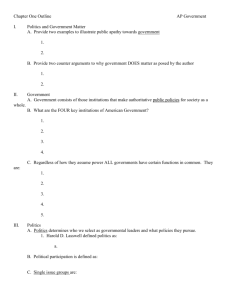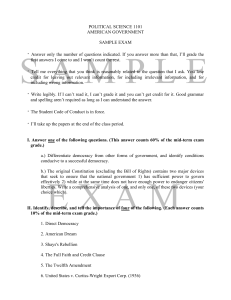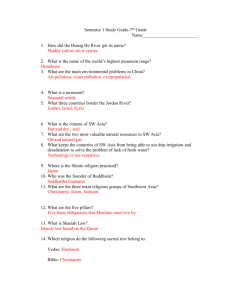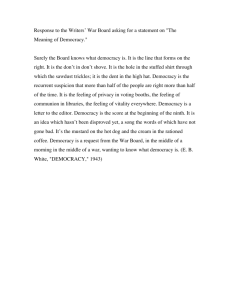American Government
advertisement
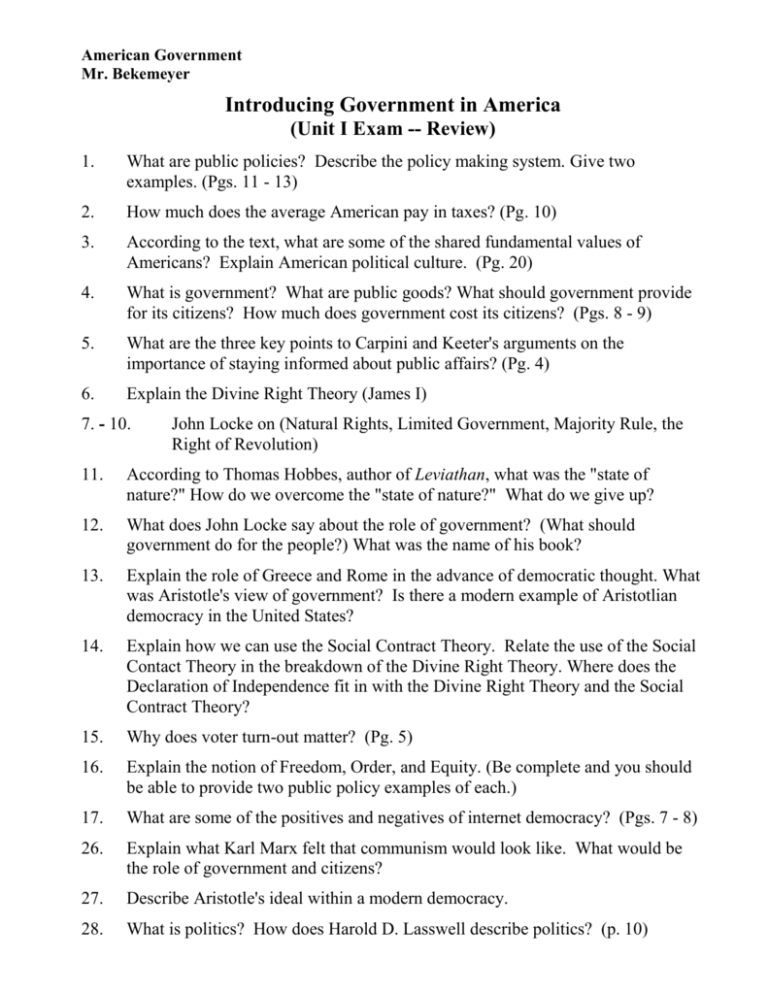
American Government Mr. Bekemeyer Introducing Government in America (Unit I Exam -- Review) 1. What are public policies? Describe the policy making system. Give two examples. (Pgs. 11 - 13) 2. How much does the average American pay in taxes? (Pg. 10) 3. According to the text, what are some of the shared fundamental values of Americans? Explain American political culture. (Pg. 20) 4. What is government? What are public goods? What should government provide for its citizens? How much does government cost its citizens? (Pgs. 8 - 9) 5. What are the three key points to Carpini and Keeter's arguments on the importance of staying informed about public affairs? (Pg. 4) 6. Explain the Divine Right Theory (James I) 7. - 10. John Locke on (Natural Rights, Limited Government, Majority Rule, the Right of Revolution) 11. According to Thomas Hobbes, author of Leviathan, what was the "state of nature?" How do we overcome the "state of nature?" What do we give up? 12. What does John Locke say about the role of government? (What should government do for the people?) What was the name of his book? 13. Explain the role of Greece and Rome in the advance of democratic thought. What was Aristotle's view of government? Is there a modern example of Aristotlian democracy in the United States? 14. Explain how we can use the Social Contract Theory. Relate the use of the Social Contact Theory in the breakdown of the Divine Right Theory. Where does the Declaration of Independence fit in with the Divine Right Theory and the Social Contract Theory? 15. Why does voter turn-out matter? (Pg. 5) 16. Explain the notion of Freedom, Order, and Equity. (Be complete and you should be able to provide two public policy examples of each.) 17. What are some of the positives and negatives of internet democracy? (Pgs. 7 - 8) 26. Explain what Karl Marx felt that communism would look like. What would be the role of government and citizens? 27. Describe Aristotle's ideal within a modern democracy. 28. What is politics? How does Harold D. Lasswell describe politics? (p. 10) 29. How is it going? These review sheets sure can get long ... 30. Explain the Majoritarian model (referendum, initiative). 31. English common law gave us ... 32. Describe the policy making system. (pps. 11-12) 33. What is a linkage institution? Describe the policy agenda. (pps. 11 - 13) Give examples. 34. Pluralism? Hyperpluralsim? Elite theory? 35. Using the text, what are the modern challenges to Democracy? (p. 18) 36. How does Abraham Lincoln summarize democracy? Explain. 37. What are the five concepts behind democracy? 38. Explain what is meant when we say that the fundamental worth of the individual must be of overriding importance. 39. Explain individual v. society. What is meant by "equality of all persons?’ 40. In terms of equality, what does democracy attempt to guarantee? What are the protected classes? 41. What are two things we can say about majority rule? Is it always perfect? Describe the process. 42. What is the danger of majority rule? What must the majority guarantee the minority? 43. Define democratic compromise. What do we allow the individual in a democracy? 44. How did the Constitutional framers feel about Democracy? (p. 14) 45. Can democracy survive when the rights of one group are usurped by another (lawful or otherwise)? 46. Explain the notion of balance between the rights of the individual and the rights of the society. 47. Explain why the free exchange of ideas is so vital to a democracy. 48. What was the modern dilemma and the original dilemma? 49. Communitarians? Libertarians? Liberals? Conservatives? 50. Describe the bases of individual power. (see reading) 51. What are the challenges to democracy? (pp. 18 - 19) 52. Explain the concept of "culture war." (p. 22) The Magna Charta stressed that ... 53. How active is the American government? (p. 24) Key terms (each must be placed on a note card) and defined. UNIT I – INTRODUCING GOVERNMENT IN AMERICA Power defined Government defined Public goods Politics defined Political participation methods Majoritarian politics Policy agenda Public policy Political system defined Political issue Linkage institutions Democracy (Direct and Indirect) Traditional democratic theory Majority rule Pluralism Representation Hyperpluralism Elitism or class theory Republic Majority rule with due regard for minority rights

